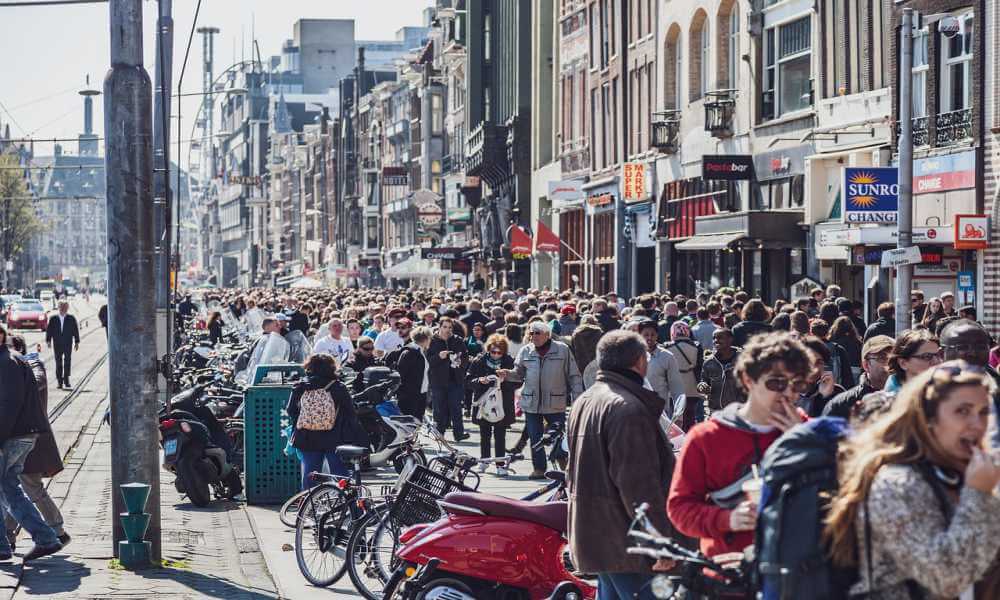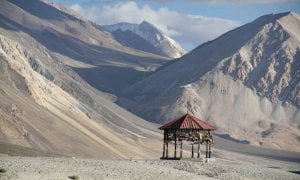Mass Tourism is a kind of tourism in which there is huge gathering of tourist in a destination and creates huge impact upon its carrying capacity. It includes the assembly of visitors, tourists or voyagers going to a similar destination put regularly in the meantime of year. It is likewise considered as the ease approach to earn more profit in the destination and marketed as a packaged tour such as places of Manali, Shimla, Goa, Nainital as places of Mass tourism .Mass tourism added to the development of provincial and local and global tourism. In fact ass is a term that portrays individuals gathered together, or extensive quantities of individuals. Mass tourism is a thought that has been a piece of scholastic and expert travel exchanges for long.

- In the event that we go to history we see that in 1950 There were in all out 25 million visitor entries all around.
- There were 278 million tourist arrivals in 1980 globally.
- There were 528 million tourist arrivals in 1995 globally.
- There were 1.23 billion tourists in 2016 globally (UNWTO 2016) .
- It is estimated of UNWTO that by the year 20130 there will be 1.8 billion tourists by 2030.
- Mass tourism is the consequence of mass excursion implies individuals are having room schedule-wise to movement and unwind or take rest from work.
- In display time there is an expansion in the number of tourists since individuals are having more recreation time and discretionary income that is contributing for more mass tourism
- Additionally there are more individuals living past the retirement age who can appreciate tourism.
- Mass tourism relies on specific variables for the development, for example, increment of relaxation time as well as the structure of time accessible and on the financial matters of tourism and friendliness industry.
- The lifetime dispersion of extra time has likewise been a vital effect on mass tourism.
- The growth of senior citizen with discretionary money has contributed for mass tourism

History of Mass Tourism
- Tourism represents around 10 percent of the world’s GDP contribution and is one of the primary generators of business.
In the early years of the twentieth century, tourism kept on growing as an outcome of expanding income, premium and friendly states of mind, and changes in individuals’ travel patterns.
Advances in transport enabled individuals to movement in masses.
- Indeed, mass creation and mass utilization was the method of reasoning of that period.
- In early eighteenth century, travel was as yet a curiosity for the masses, and the homogeneous character of the request prompted the generation of institutionalized items that could suit everybody.
- The interest for tourism is affected by the image markers who adequately make vacation spots.
- This is a different industry and incorporates originators of lodgings and attractions and in addition media and travel writers.
- The idealistic hover of mass tourism has five principle stages; regardless, mass tourism developed in the USA in the decades of nineteen thirties.
Two imperative conditions were: the spread of paid holidays and the expansion of auto cars. The development of motel chains likewise gave the important settlement framework to the rising tourism industry.
The goals of most visitors were waterfront region and spa resortregionss. There was some common laborers tourism in Europe as of now coordinated at the coastal.
First Stage of Mass Tourism (1930s onwards)
- From the decade of 1930s onwards, the development of car invigorated.
- During second world war the advancement of aviation technology started
- Growth in aviation sector enhanced the travel of wealthy people of the world. The beginning of holiday camps encouraged middle and low class people to travel for the sake of leisure.
- The moment accomplishment of the idea brought about the development of low cost accommodation and facilities everywhere throughout the coastal areas and beaches.
Second Stage of Mass Tourism (1950’s)
- In the second stage in the fifties household mass tourism developed in Europe fuelled by recreation time and auto car possession.
- The beaches and seaside areas were the main tourism destinations for rural and coastal tourism in many countries.
Third Stage of Mass Tourism (1960’s)
- In the third stage the late sixties mass tourism built up another measurement, being progressively internationalized.
- In the vicinity of 1950 and 1988, the quantity of global travellers expanded from 25 million to 389 million.
Fourth stage of Mass Tourism (1970’s)
In the fourth stage there was an Europeanization of global tourism from the 1960s.
As indicated by the World Tourism Organization, globally there were 405 million worldwide tourists in 1989; the developments were for the most part inside that mainland.
The development of mass tourism was encouraged by the facilitating of movement directions and by the development of the universal air travel industry.
Fifth stage of Mass Tourism (Late 20th Century)
- In the last stage in the late twentieth century there has been a globalization of the tourism business.
- Globalization has happened as an ever increasing number of nations have progressed toward becoming bolted into universal travel.
- Tourism from Japan, Europe, North America, Australia, India and the Middle East has turned out to be progressively internationalized.
- In the meantime, the scope of goals of mass tourism has expanded.
Reasons for growth mass tourism
Explanations behind mass tourism are as per the following:
- Sustained flourishing and resulting ascend in the pay of the general population
- Increase in paid recreation time
- Rise in instructive standard;
- Reduction in the measure of family
- Development of good correspondence framework
- Growth of travel agents and tour operators
- Monotony of work life in an industrialized society
- Growth in the quantity of International Conferences
Advantages of Mass Tourism
- Jobs are produced by tourism in numerous territories – in the underlying development of the resorts, in movement, in sustenance arrangement and in other administration related businesses.
- Local people get advantage specifically from work
- Roads, rail, power and other services are developed for tourists, local people also get advantage from these infrastructure.
- Transport services are created
- The local duty and tax base builds of local government/board increasers that can be used for schools, human services and social administrations.
- Tourists present new esteems and societies and find out about new societies this causes social comprehension
Disadvantages of Mass Tourism
1) Various international companies also become the part of business in – this can bring about the leakage of benefits to other countries.
2 Jobs can be occasional – particularly in shoreline and skiing based resorts. Individuals can consequently wind up out of work in the nearby season.
- Tourists devour tremendous measures of assets including sustenance and water – this sort of tourism is especially unsustainable in this way.
- Tourists present new esteems and societies – this causes social contamination.
- Land is lost from cultivating to tourists infrastructure and improvements.
FACTORS CONTRIBUTED THE GROWTH OF MASS TOURISM
- The variables that made room for mass tourism for its brilliant age are specifically technology, generation and management related changes in the advance.
- The hotel chains, airlines, business ventures, travels and short breaks have been the elements that helped advancement of mass tourism in the advance.
- Tour operators, sanction flights, and comprehensive tours particularly occasion package tours are the identifiers of mass tourism.
- The factors that changed the world tourism business and appropriately mass tourism could be condensed as being technology, air transportation, settlement organizations, tour operators, combinations and mass utilization relying upon occasion needs.
Role of Technology in Mass tourism
- Technology today is seriously associated with every one of the enterprises, controlling the business world and the tourism business isn’t the special case.
- The effects of technology are generally observed on the aircrafts, credit cards and travel checks, computers reservation systems etc has made travel more easy and accessible
- The technology helped to make the correspondence among coordinators and manufacturers of services when the tourism business’ mass tourism age is considered.
- Technology has straightforwardly influenced tourism on four noteworthy subjects: aircrafts, plastic cards and travel checks, computers and reservation systems.
- The essential impact of technology on the aircraft technology is connected with the Second World War.
- The war incidentally enhanced business flights; however it brought huge long-run picks up for the improvement of the air transportation industry.
- There was a growth of vast number of experienced pilots.
- There was huge increase in interest among people about flying, as a huge number of military and civilians experienced their first flight journey.
- Increased information of the climate;
- Improved maps and information of remote landscape;
- Construction of thousands of airfields in wide parts of the world;
- In the early years of mass tourism, computer technology was still in its early stages. Along these lines, computers were utilized mostly to plan and conveyance procedure of the tourist item.
- Computers were increasingly the facilitators of the brilliant time of mass tourism.
- The present computers are additionally identifiers in either generation or showcasing phases of the tourism business with the assistance of the correspondence innovations.
- The most eminent effect of the technology in the brilliant age is connected to the Computer Reservation Systems (CRSs).
- Airlines, hotels and tour operators set up their own CRSs. CRSs in the early years were serving moronic terminals without intranet or web and they were not working synchronously.

A. Air transportation
- Air transportation enhanced tourism significantly globally; unlike every other transportation mode in modern tourism it eased the accessibility of destinations and comprehensive tours.
- The two most critical parts of international package tour was accommodation and air travel
- Today, there are more than 365 Commercial Airlines worldwide and there are around 5000 airlines with IATA codes.
- The more imperative improvement of air transportation with respect to mass tourism is the sanction flights and the equivalent rights which were given to contract and booked organizations for the new headings in 1960.
- By methods for the said rights, monopolist air transportation showcase has ended up being more sensible for tour operators.
- The airlines could arrange flights with the liberalizations to new goals that were beforehand worked just by the booked airlines.
- The travellers were the most profited leg of these changes and liberalizations.
- Tourists could discover more contrasting options to more goals with better administrations here and there, and paying not exactly previously.
- Notwithstanding, this was another shoot impact for mass tourism’s brilliant age that more individuals could compose their own movement.
B. Hotels
- Tour operators and the chain hotels and airline companies were the main determinants in the advancement of mass tourism.
- The development of hotels, motels, resorts, ascent of lavish hotels being worked everywhere throughout the nation , chain hotels and the airline companies being the initiator of mass tourism.
- Surface and the rail transportation decided the advancement of accommodation organizations, prompted the development of new hotels and motels in goals and junction.
- The beginning of the airline business flagged the start of the end, for longseparate rail benefits as well as, more conclusively, for the considerable steamship companies.
- The appearance of air transportation prompted an exponential development as tourists could travel anyplace with a quick, dependable and routine system.
- The expanding number of individuals voyaging brought about the regulation of little, free hotels changed over to multi-accomplice companies, working with establishment system, profiting money related instruments, for example, renting, management contracts and so forth.
- Multinational hotel companies had likewise made imperative interests in the creating nations.
- Tourism was acknowledged to be a critical medium for expanding work openings and decreasing the outside money deficiency in the developing countries.
- Mass tourism is fundamentally created in types of package tours from various countries to emerging and developed tourist destinations.
- Tour operators in developing nations arranged package tours by making contracts with accommodation principals and airline companies, and offered these tours to customers in movement offices by means of movement writing, for example, pamphlets, flyers and so on.
Some Serious Issues That Causing Tourism Problems
- The tourism emergency is the effects that including 800 million extra universal guests for each year to the tourism business, also the expansion of tourism visits that may happen inside national outskirts.
- Including 800 million guests a year is what might as well be called including 8 or 9 Walt Disney Worlds to the tourism industry.
- The difficulties of how to build offices, give vitality, water and waste management, grow new nourishment supplies, and ensure cultural legacies of local groups, is an immense emergency, to be sure.
- The treats of mass tourism have taken numerous structures. For instance, as of now we have seen what happens when:
- Coastal tourism offices with poor development are hit by sea tempests.
- Tourist destinations are suffering from shortage the water supply far from the local community to serve tourist resorts.
- Various tourist spots going from net exporters to net shippers of sustenance.
- Increased vitality utilization and coming about carbon discharges.
- Increased waste and contamination issues.
- Increased clashes with indigenous societies and land proprietorship.
Then again, tourism can likewise bring numerous positive advantages and really enhance the manageability of a community. A portion of the potential positive effects include:
- Financial commitments for community improvement and environmental assurance.
- Improved environmental management and planning.
- Increased environmental training and mindfulness programs.
- Improved security and authorization of environmental laws and directions.
- Improved zoning and construction laws for environmental assurance and calamity diminishment.
- New work openings and monetary advancement for destitution stricken territories.
- There are numerous cases of what people and associations are doing to enhance nature for tourism and local groups.



